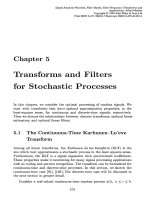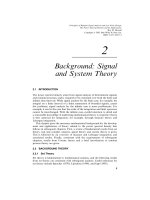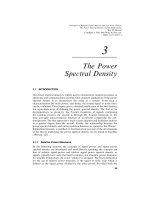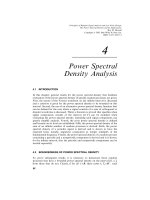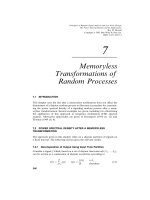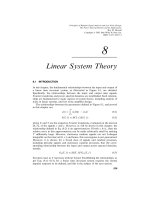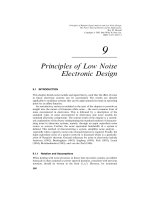Nguyên tắc phân tích tín hiệu ngẫu nhiên và thiết kế tiếng ồn thấp P1
Bạn đang xem bản rút gọn của tài liệu. Xem và tải ngay bản đầy đủ của tài liệu tại đây (55.31 KB, 2 trang )
1
Introduction
Random phenomena have their basis in the nature of the physical order (e.g.,
the nature of electron movement) and limit the performance of many systems
including electronic and communication systems. For example, the minimum
sensitivity of an amplifier and the distance a signal can be transmitted and
recovered, are both limited by random signal variations. On the other hand,
there are applications where introduced randomness will enhance aspects of
system performance. One example is where a low level randomly varying
waveform is added to a repetitive signal to improve the resolution in signal
values obtained by an analogue to digital converter, and, after averaging
(Potzick, 1999; Gray, 1993). Further, in recent years there has been increasing
interest in stochastic resonance which occurs when the system response to a
weak periodic signal is enhanced by an increase in the level of random
variations associated with the system (Luchinsky, 1999; Hanggi, 2000).
The importance of random phenomena has led to an increasing number of
theoretical results as can be found in books such as, Gardner (1990), Papoulis
(2002), and Taylor (1998). In communications and electronics a standard way
of characterizing random phenomenon is through a power spectral density
which, for example, facilitates derivation of the signal to noise ratio of a system
operating under prescribed conditions. There are two standard approaches for
defining the power spectral density. First, there is a direct Fourier approach.
Second, and more commonly, an approach based on the Fourier transform of
an autocorrelation function.
With the direct Fourier approach the power spectral density of a single
signal x, for the interval [0, T ], is defined as
G(T, f ) :
"X(T, f )"
T
(1.1)
where X is the Fourier transform of x evaluated over the interval [0, T ].
The alternative approach is to determine the autocorrelation of the signal,
1
Principles of Random Signal Analysis and Low Noise Design:
The Power Spectral Density and Its Applications.
Roy M. Howard
Copyright
¶
2002 John Wiley & Sons, Inc.
ISBN: 0-471-22617-3
defined as
R(T, t, ) :
x(t)x*(t 9 )
0
t + [0, T ], t 9 + [0, T ]
elsewhere
(1.2)
and then take a time average to form an averaged autocorrelation function:
R
(T, ) :
1
T
2>O
R(T, t, ) dt :0
1
T
2
O
R(T, t, ) dt 90
(1.3)
Finally, the Fourier transform of this function is taken to obtain the power
spectral density, that is,
G(T, f ) :
2
\2
R
(T, )e\HLDO d (1.4)
These two approaches lead to identical power spectral density functions where
the definitions can be readily generalized for random processes and the infinite
time interval. Analytically, the Fourier approach is more direct and leads
directly to the interpretation of the power spectral density, at a given frequency,
as being proportional to the power in the constituent sinusoidal signal with
that frequency. Further, the direct nature of the Fourier approach facilitates
the derivation of the power spectral density of signals and random processes.
The following chapters give a systematic account of the theory related to the
direct Fourier approach to defining and evaluating the power spectral density.
This theory is applied to the derivation of the power spectral density of the
random processes commonly encountered in communications and electronics,
noise analysis in linear electronic systems, and memoryless transformations of
random processes.
Chapter 2 gives appropriate background theory for this book, while
Chapter 3 gives a detailed discussion of the two alternative ways the power
spectral density can be defined and the equivalence between them. Chapter 4
gives important results that facilitate the derivation of the power spectral
density. Chapter 5 and 6 detail the derivation of the power spectral density of
standard random processes encountered in communications and electronics.
Chapter 7 details an approach for ascertaining the power spectral density of
random processes after a nonlinear memoryless transformation. Chapter 8
discusses the relationship between the input and output signals, and input and
output power spectral densities of a linear time invariant system. This chapter
gives the necessary background material for Chapter 9, which details the
characterization of standard noise signals that occur in electronic devices, and
how analysis of such noise signals can be carried out to quantify, and hence,
minimize the noise of a linear electronic system.
2
INTRODUCTION

